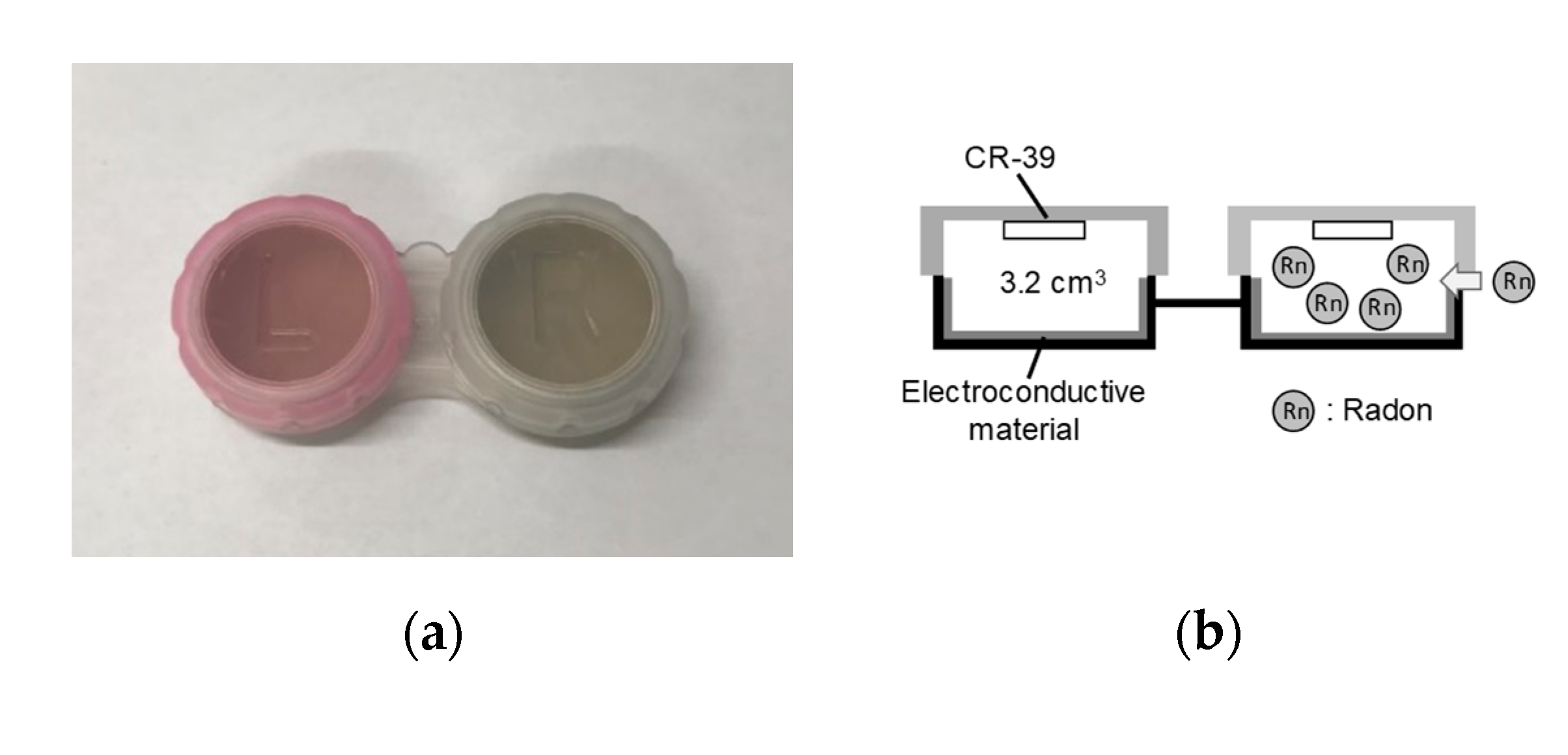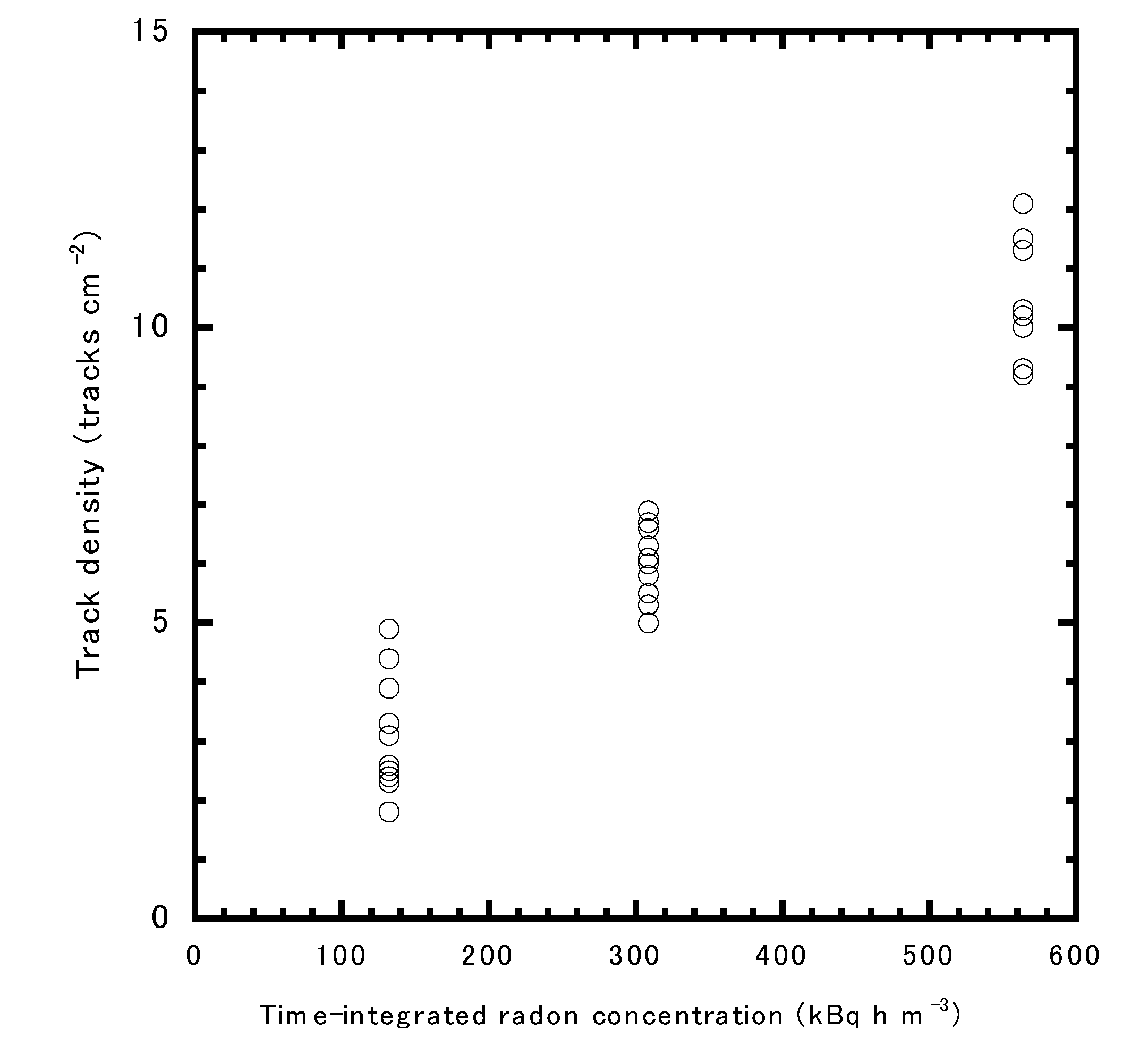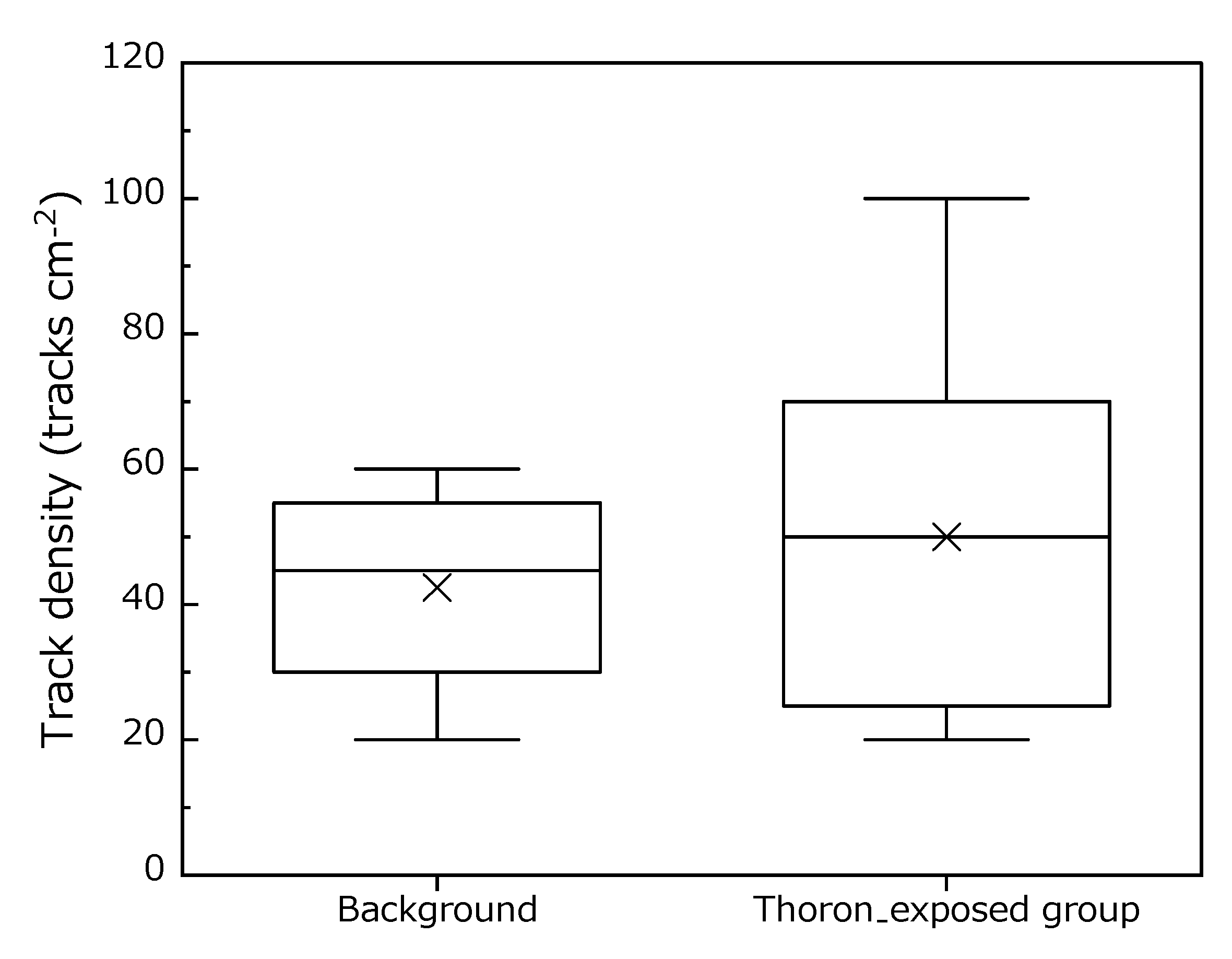Passive-Type Radon Monitor Constructed Using a Small Container for Personal Dosimetry
Abstract
1. Introduction
2. Materials and Methods
2.1. Overview of the Passive Radon Rersonal Monitor
2.2. Conversion Factor to Radon Concentration
2.3. Effect of Thoron Interference
2.4. Minimum and Maximum Detectable Radon Concentrations
2.5. Air Exchange Rate
3. Results
3.1. Conversion Factor to Radon Concentration
3.2. Effect of Thoron Interference
3.3. Minimum and Maximum Detectable Radon Concentrations
3.4. Air Exchange Rate
4. Discussion
4.1. Conversion Factor to Radon Concentration
4.2. Minimum and Maximum Detectable Radon Concentrations
4.3. Air Exchange Rate
5. Conclusions
Author Contributions
Funding
Conflicts of Interest
References
- World Health Organization. WHO Handbook on Indoor Radon: A Public Health Perspective; WHO: Geneva, Switzerland, 2009. [Google Scholar]
- United Nations Scientific Committee on the Effects of Atomic Radiation. UNSCEAR 2008 Report, Sources and Effects of Ionizing Radiation; Volume I: Annex B Exposures of the Public and Workers from Various Sources of Radiation; UNSCEAR: New York, NY, USA, 2010. [Google Scholar]
- Bochicchio, F.; Venuti, C.G.; Nuccetelli, C.; Piermattei, S.; Risica, S.; Tommasino, L.; Torri, G. Results of the representative Italian national survey on radon indoors. Health Phys. 1996, 71, 741–748. [Google Scholar] [CrossRef] [PubMed]
- Letourneau, G.E.; McGregor, G.R.; Walker, B.W. Design and interpretation of large surveys for indoor exposure to radon daughters. Radiat. Prot. Dosim. 1984, 7, 303–308. [Google Scholar] [CrossRef]
- Marcinowski, F. Nationwide survey of residential radon levels in the US. Radiat. Prot. Dosim. 1992, 45, 419–424. [Google Scholar] [CrossRef]
- Sanada, T.; Fujimoto, K.; Miyamoto, K.; Doi, M.; Tokonami, S.; Uesugi, M.; Takata, Y. Measurement of nationwide indoor Rn concentration in Japan. J. Environ. Radioact. 1999, 45, 129–137. [Google Scholar] [CrossRef]
- Omori, Y.; Hosoda, M.; Takashi, F.; Sanada, T.; Hirao, S.; Ono, K.; Furukawa, M. Japanese population dose from natural radiation. J. Radiol. Prot. 2020, in press. [Google Scholar] [CrossRef] [PubMed]
- United Nations Scientific Committee on the Effects of Atomic Radiation. UNSCEAR 2000 Report, Sources and Effects of Ionizing Radiation; Volume I: Annex B Exposures from Natural Radiation Sources; UNSCEAR: New York, NY, USA, 2000. [Google Scholar]
- Thinová, L.; Froňka, A.; Rovenská, K. The overview of the radon and environmental characteristics measurements in the Czech show caves. Radiat. Prot. Dosim. 2015, 164, 502–509. [Google Scholar] [CrossRef]
- Dinu, A.C.; Călugăr, M.I.; Burghele, B.D.; Dumitru, O.A.; Cosma, C.; Onac, B.P. Radon levels in Romanian caves: An occupational exposure survey. Environ. Geohem. Health 2017, 39, 1085–1099. [Google Scholar] [CrossRef]
- Shahrokhi, A.; Vigh, T.; Németh, C.; Csordás, A.; Kovács, T. Radon measurements and dose estimate of workers in a manganese ore mine. Appl. Radiat. Isot. 2017, 124, 32–37. [Google Scholar] [CrossRef]
- Sainz, C.; Rábago, D.; Fernández, E.; Quindós, J.; Quindós, L.; Fernández, A.; Fuente, I.; Arteche, J.L.; Quindós, L.S.; Celaya, S. Variations in radon dosimetry under different assessment approaches in the Altamira Cave. J. Radiol. Prot. 2020, 40, 367–380. [Google Scholar] [CrossRef]
- International Commission on Radiological Protection. Occupational Intakes of Radionuclides: Part 3; Annals of the ICRP: New York, NY, USA, 2017. [Google Scholar]
- Tokonami, S. Some thought on new dose conversion factors for radon progeny inhalation. Jpn. J. Health Phys. 2018, 53, 282–293. [Google Scholar] [CrossRef]
- United Nations Scientific Committee on the Effects of Atomic Radiation. UNSCEAR 2006 Report, Effects of Ionizing Radiation; Volume II: Annex E Sources-to-Effects Assessment for Radon in Homes and Workplaces; UNSCEAR: New York, NY, USA, 2009. [Google Scholar]
- Hosoda, M. Report on a technical meeting on the implications of the new dose conversion factors for radon. Jpn. J. Health Phys. 2019, 54, 226–230. [Google Scholar] [CrossRef]
- Kudo, H.; Tokonami, S.; Omori, Y.; Ishikawa, T.; Sahoo, S.K.; Akata, N.; Hosoda, M. Comparative dosimetry for radon and thoron in high background radiation areas in China. Radiat. Prot. Dosim. 2015, 167, 155–159. [Google Scholar] [CrossRef] [PubMed]
- Tokonami, S.; Takahashi, H.; Kobayashi, Y.; Zhuo, W. Up-to-date radon-thoron discriminative detector for a large-scale survey. Rev. Sci. Instrum. 2005, 76, 113505. [Google Scholar] [CrossRef]
- Szeiler, G.; Somlai, J.; Ishikawa, T.; Omori, Y.; Mishra, R.; Sapra, B.K.; Mayya, Y.S.; Tokonami, S.; Csordás, A.; Kovács, T. Preliminary results from an indoor radon thoron survey in Hungry. Radiat. Prot. Dosim. 2012, 152, 243–246. [Google Scholar] [CrossRef] [PubMed]
- Pornnumpa, C.; Oyama, Y.; Iwaoka, K.; Hosoda, M.; Tokonami, S. Development of radon and thoron exposure system at Hirosaki University. Radiat. Environ. Med. 2018, 7, 13–20. [Google Scholar]
- Tokonami, S.; Yang, M.; Yonehara, H.; Yamada, Y. Simple, discriminative measurement technique for radon and thoron concentrations with a single scintillation cell. Rev. Sci. Instrum. 2002, 73, 69–72. [Google Scholar] [CrossRef]
- International Organization for Standardization. Determination of the Characteristic Limits (Decision Threshold, Detection Limit and Limits of the Confidence Interval) for Measurements of Ionizing Radiation—Fundamentals and Application ISO11929; ISO: Geneva, Switzerland, 2010. [Google Scholar]
- Omori, Y.; Janik, M.; Sorimachi, A.; Ishikawa, T.; Tokonami, S. Effects of air exchange property of passive-type radon-thoron discriminative detectors on performance of radon and thoron measurements. Radiat. Prot. Dosim. 2012, 152, 140–145. [Google Scholar] [CrossRef]
- Urban, M.; Piesch, E. Low level environmental radon dosimetry with a passive track etch detector device. Radiat. Prot. Dosim. 1981, 1, 97–109. [Google Scholar]
- Pearson, M.D.; Spangler, R.R. Calibration of alpha-track monitors for measurement of thoron (220Rn). Health Phys. 1991, 60, 697–701. [Google Scholar]
- Tokonami, S. Summary of dosimetry (radon and thoron) studies. In Proceedings of the Sixth International Conference on High Levels of Natural Radiation Areas, Osaka, Japan, 6–10 September 2004; Volume 1276, pp. 151–154. [Google Scholar]
- Doi, M.; Kobayashi, S. The passive radon-thoron discriminative dosimeter for practical use. Jpn. J. Health Phys. 1994, 29, 155–166. [Google Scholar] [CrossRef]
- McLaughlin, J.P.; Fitzgerald, B. Model for determining the response of passive alpha particle detectors to radon and its progeny in cylindrical detecting volumes. Radiat. Prot. Dosim. 1994, 56, 241–246. [Google Scholar] [CrossRef]
- Quindos, L.S.; Fernandez, P.L.; Soto, J. National survey on indoor radon in Spain. Environ. Int. 1991, 17, 449–453. [Google Scholar] [CrossRef]
- Espinosa, G.; Golzarri, J.I.; Rickards, J.; Gammage, R.B. Distribution of indoor radon levels in Mexico. Radiat. Meas. 1991, 31, 355–358. [Google Scholar] [CrossRef]
- Khan, A.J. A study of indoor radon levels in Indian dwellings, influencing factors and lung cancer risks. Radiat. Meas. 2000, 32, 92–97. [Google Scholar] [CrossRef]
- Kim, C.K.; Lee, S.C.; Lee, D.M.; Chang, B.U.; Rho, B.H.; Kang, H.D. Nationwide survey of radon levels in Korea. Health Phys. 2003, 84, 354–360. [Google Scholar] [CrossRef]
- Radolić, V.; Vuković, B.; Stanić, D.; Katić, M. National survey of indoor radon levels in Croatia. J. Radioanal. Chemist. 2006, 269, 87–90. [Google Scholar] [CrossRef]
- Dowdal, A.; Murphy, P.; Pollard, D.; Fenton, D. Update of Ireland’s national average indoor radon concentration—Application of a new survey protocol. J. Environ. Radioact. 2017, 169–170, 1–8. [Google Scholar] [CrossRef]




| Parameter | Radon Chamber | Experimental Room | ||
|---|---|---|---|---|
| Average | Standard Deviation | Average | Standard Deviation | |
| Radon concentration (Bq m−3) | 13,300 | 1603 | 7.7 | 3.0 |
| Temperature (°C) | 27.7 | 0.4 | 26.3 | 1.5 |
| Relative humidity (%) | 50.1 | 2.5 | 34.7 | 6.1 |
| Air pressure (hPa) | 1002 | 2 | 1003 | 7 |
| Item | Symbol | Value | Remarks |
|---|---|---|---|
| Quantiles of the standardized normal distribution | k | 1.65 | For probabilities of 0.95 |
| Number of background track | n0 | 4.3 tracks | Derived from the background track density of 43 tracks cm−2 |
| Total reading area | S | 0.1 cm2 | Ten reading areas of 0.01 cm2 |
| Conversion factor for radon concentration | CF | 2.0 tracks cm−2 per kBq h m−3 | |
| Measurement time | T | 720 h | 3 months |
| 1440 h | 6 months | ||
| Relative standard uncertainty for the total reading area | 0 | ||
| Relative standard uncertainty For the conversion factor | 0.15 |
| Measuring Device | Conversion Factor (Tracks cm−2 per kBq h m−3) | Reference |
|---|---|---|
| Present radon monitor | 2.0 | |
| RADUET 1 | 2.3 | [18] |
| KfK monitor 2 | 0.9 | [24] |
| Radtrak | 2.8 | [25] |
| NRPB/SSI 3 | 2.2 | [26] |
| Radon-thoron discriminative dosimeter 1 | 1.2 | [27] |
| Item | Conversion Factor (Tracks cm−2 per kBq h m−3) | |
|---|---|---|
| Nagase Landauer | RadoSys 1 | |
| Present study | 4.4 | 2.8 |
| Previous report 2 | - | 2.3 |
© 2020 by the authors. Licensee MDPI, Basel, Switzerland. This article is an open access article distributed under the terms and conditions of the Creative Commons Attribution (CC BY) license (http://creativecommons.org/licenses/by/4.0/).
Share and Cite
Tamakuma, Y.; Kranrod, C.; Suzuki, T.; Watanabe, Y.; Ploykrathok, T.; Negami, R.; Nugraha, E.D.; Iwaoka, K.; Janik, M.; Hosoda, M.; et al. Passive-Type Radon Monitor Constructed Using a Small Container for Personal Dosimetry. Int. J. Environ. Res. Public Health 2020, 17, 5660. https://doi.org/10.3390/ijerph17165660
Tamakuma Y, Kranrod C, Suzuki T, Watanabe Y, Ploykrathok T, Negami R, Nugraha ED, Iwaoka K, Janik M, Hosoda M, et al. Passive-Type Radon Monitor Constructed Using a Small Container for Personal Dosimetry. International Journal of Environmental Research and Public Health. 2020; 17(16):5660. https://doi.org/10.3390/ijerph17165660
Chicago/Turabian StyleTamakuma, Yuki, Chutima Kranrod, Takahito Suzuki, Yuki Watanabe, Thamaborn Ploykrathok, Ryoju Negami, Eka Djatnika Nugraha, Kazuki Iwaoka, Mirosław Janik, Masahiro Hosoda, and et al. 2020. "Passive-Type Radon Monitor Constructed Using a Small Container for Personal Dosimetry" International Journal of Environmental Research and Public Health 17, no. 16: 5660. https://doi.org/10.3390/ijerph17165660
APA StyleTamakuma, Y., Kranrod, C., Suzuki, T., Watanabe, Y., Ploykrathok, T., Negami, R., Nugraha, E. D., Iwaoka, K., Janik, M., Hosoda, M., & Tokonami, S. (2020). Passive-Type Radon Monitor Constructed Using a Small Container for Personal Dosimetry. International Journal of Environmental Research and Public Health, 17(16), 5660. https://doi.org/10.3390/ijerph17165660










